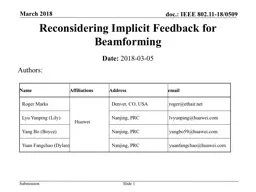PPT-Implicit and Explicit Evaluations of Feminist Prototypes Pr
Author : min-jolicoeur | Published Date : 2017-04-11
Identity and Behavior Liz Redford Kate A Ratliff amp Jordan Rogaliner University of Florida Background Purpose to examine whether attitudes toward feminist prototypes
Presentation Embed Code
Download Presentation
Download Presentation The PPT/PDF document "Implicit and Explicit Evaluations of Fem..." is the property of its rightful owner. Permission is granted to download and print the materials on this website for personal, non-commercial use only, and to display it on your personal computer provided you do not modify the materials and that you retain all copyright notices contained in the materials. By downloading content from our website, you accept the terms of this agreement.
Implicit and Explicit Evaluations of Feminist Prototypes Pr: Transcript
Download Rules Of Document
"Implicit and Explicit Evaluations of Feminist Prototypes Pr"The content belongs to its owner. You may download and print it for personal use, without modification, and keep all copyright notices. By downloading, you agree to these terms.
Related Documents














